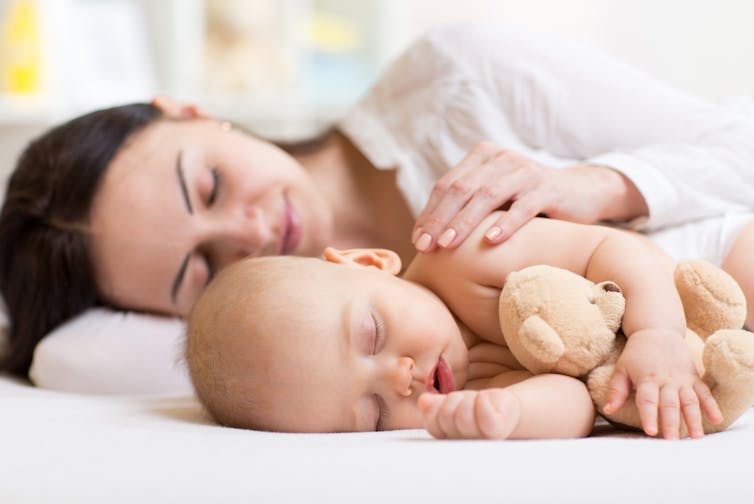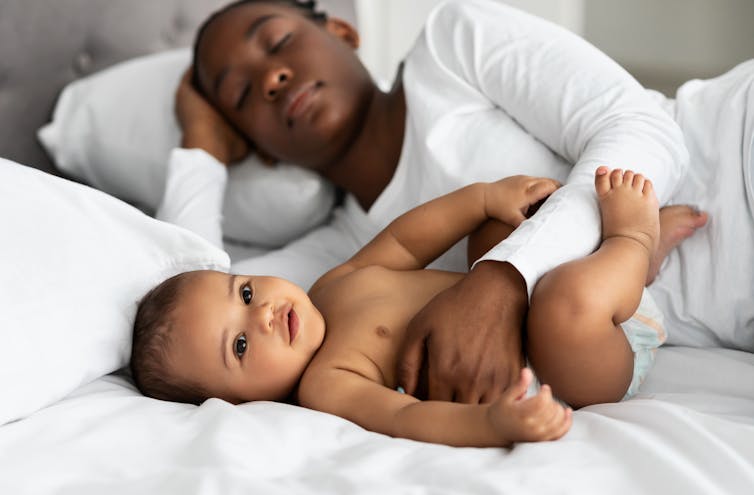
(Shutterstock)
Gabrielle Fréchette-Boilard, Université du Québec à Trois-Rivières (UQTR) et Evelyne Touchette, Université du Québec à Trois-Rivières (UQTR)
Sleeping with your baby is not life-threatening, but it’s not essential either. Rather, it’s a family choice that you should make with your partner.
However, in order to make the right decision you need to have access to reliable information. The choice of sleeping arrangements at the beginning of your child’s life depends on a multitude of factors. So-called co-sleeping has become a polarizing subject. The important questions surrounding the practice are often drowned out in a whirlwind of information and opinions. Parents can quickly find themselves struggling over the best choice.
As researchers at the Université du Québec à Trois-Rivières and experts in early childhood and the sleep of children and teenagers, we’ve surveyed the scientific studies on co-sleeping in order to show both sides of the coin.
What do we mean by co-sleeping?
To start with, co-sleeping is a sleeping arrangement. It is not a method used for falling asleep, although sleeping arrangements strongly influence this.
There are two types of co-sleeping:
- Co-sleeping on a shared surface, as in sharing the same bed; and
- Co-sleeping in the same room, which involves sharing the same sleeping area.
A recent Canadian study reported that about a third of mothers co-sleep on the same surface, while 40 per cent said they had never co-slept at all. A Québec study in the late 1990s revealed that one-third of mothers co-slept in the same room.
The Canadian Paediatric Society states: “For the first 6 months, the safest place for your baby to sleep is on their back, in a crib, cradle or bassinet that is in your room (room sharing).”
Two schools of thought
After it came to light in the late 2000s that Canada had high mortality rates among infants (one per thousand), society adopted a rather alarmist view of co-sleeping.
The first school of thought focuses on the medical aspects of co-sleeping linked to the risks of sleeping with a baby, such as choking, crushing or sudden infant death syndrome.
The second school aims to facilitate the practice of breastfeeding and the inclusion of cultural and family values and believes that co-sleeping promotes them.
These two main schools of thought coexist, which explains why the choice of sleeping arrangements in the early months can become so challenging for parents.
Better for breastfeeding and communication
Does co-sleeping promote breastfeeding during the night? Yes, according to scientific studies. But it’s hard to say whether it’s breastfeeding that favours this practice or whether it’s the other way around. In any case, breastfeeding is the main reason why mothers choose shared-surface co-sleeping.
However, no difference was found between breastfeeding at night and the two types of co-sleeping. In other words, sleeping in the same room is just as conducive to breastfeeding as is sleeping on a shared surface.
The same applies to meeting the child’s needs. According to a scientific study, physical contact and proximity in the same room promote the synchronization of the child’s circadian rhythm with that of the parent. This helps the baby consolidate their sleep. This would make parents more alert to the infant’s signals in both types of sleep arrangement. And that, in turn, would help communication and make it possible to respond easily and quickly to the baby’s needs.

(Shutterstock)
Less stress
While co-sleeping is known to reduce a baby’s stress, it depends on the level.
One study that asked parents about this subject found that children who had experienced one of two co-sleeping arrangements had lower anxiety levels at preschool age compared with those who had co-slept for less than six months.
Another study showed that children who slept with a parent had a lower stress response at 12 months of age compared with those who did not. However, when comparing a higher stress situation (e.g. getting a vaccination) to a moderate stress situation (e.g. during bath time), the difference between the two groups was smaller. It should be noted that several variables still need to be tested in order to fully understand this relationship, and that the two types of co-sleeping arrangements were not compared.
More disturbed and fractured sleep
Babies who co-sleep wake up more often than those who sleep alone at the beginning of life. This is also true for parents.
A study measuring the amount of sleep at six, 12 and 18 months showed that the group of children co-sleeping on a shared surface or in the same room had more nocturnal arousals, measured by actigraphy at six months. They also had more arousals measured by the mothers’ sleep diaries at six, 12 and 18 months, compared with the group of children sleeping alone.
At 12 months, the solitary sleepers had a longer average sleep time. These results were obtained after controlling for type of feeding (breast or bottle). However, the study did not investigate whether sleep characteristics differed between the two types of co-sleeping.
Mothers who co-sleep on a shared surface report that their babies fall asleep more easily and quickly, but wake up more frequently. They say they choose this arrangement to improve their family’s sleep.
Mothers generally perceive no sleep difficulties in their babies. But when mothers’ sleep is measured by actigraphy, it is more fragmented and disturbed for the first 18 months compared with those who opted for a solitary sleep arrangement.
Another objective study reveals that co-sleeping on a shared surface over the longer term (for the first two years of the child’s life) is associated with a shorter sleep duration at night, a greater need for naps during the day, and a higher proportion of difficulties falling asleep.
Attachment: no clear answers
Is co-sleeping on a shared surface associated with stronger attachment to the child?
This subject is controversial.
Some studies have reported a stronger attachment bond in babies who co-slept on a shared surface compared with those who slept alone.
Others report no link, either positive or negative, between parent-child attachment and sleep arrangement after the child’s first six months of life.
Parents’ choice
This scientific data will help parents choose the sleeping arrangement that’s right for them and their family. The decision remains a parental choice.
If you opt for a co-sleeping arrangement, you can find the safety measures to put in place on the Health Canada site in order to make sure everyone gets a good night’s sleep.![]()


